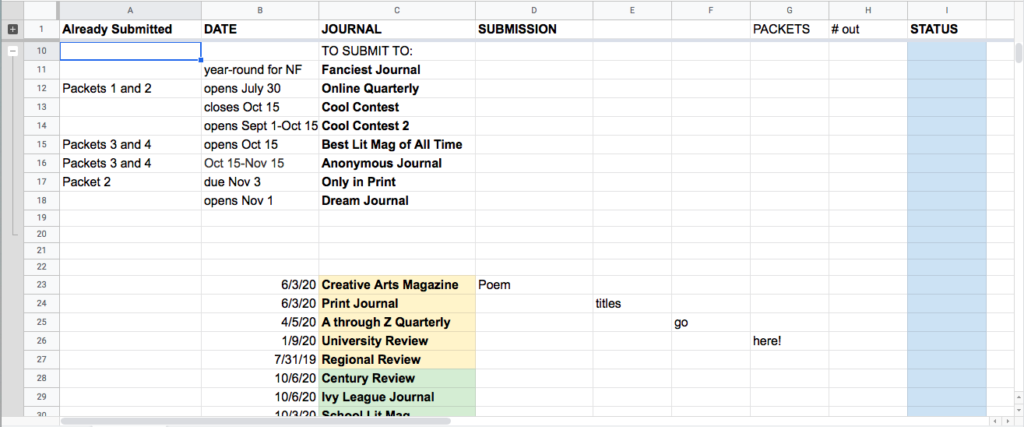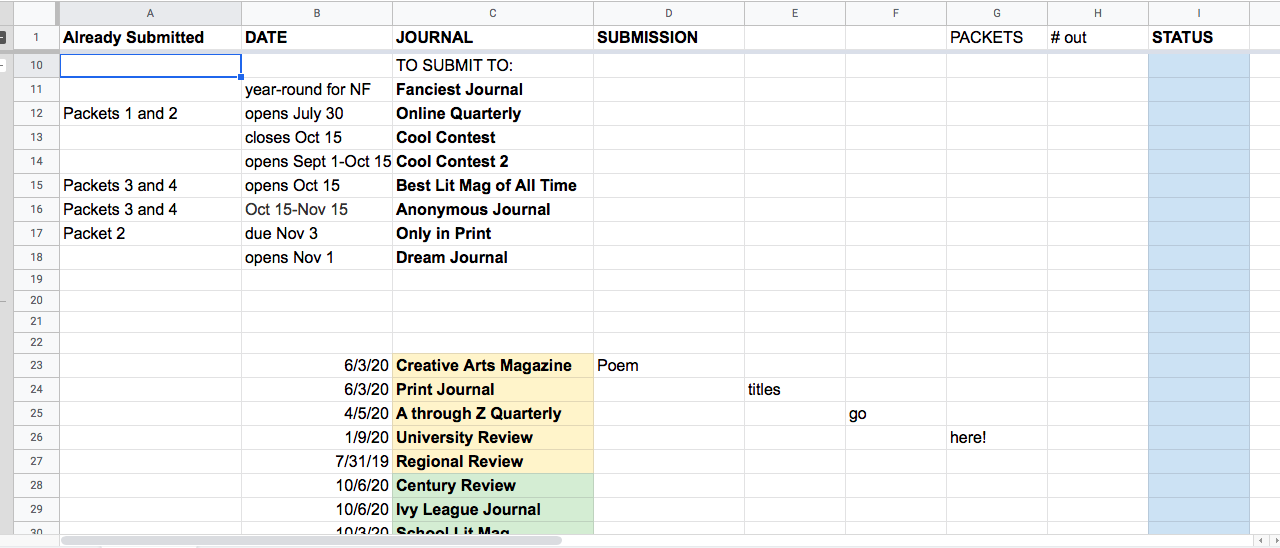
Assistant Editor Lisa Low: One Sunday this summer, I looked up from my computer and realized I’d spent an embarrassingly long time researching and thinking about where to submit my work. My brain felt jumbled from looking at my submission spreadsheet, which, although up-to-date and ordered from newest to oldest entries, felt counterproductive in my submission process. I’d spent much of my time searching the spreadsheet, double-checking which places I’d submitted the same packet of poems to, what pieces I’d sent a particular magazine in the past, and when I’d mixed poems from different packets—one of the cardinal sins of submitting. As someone who has always loved home-makeover shows, I thought there must a way to overhaul my tracking process, some equivalent to the IKEA closet system or KonMari folding method.
You can find online resources on formatting your submission, what to write in a cover letter, and tips on submission strategies, but not as much on how to create a user-friendly submission spreadsheet. So my revamp involved a lot of trial and error. My changes included:
- Using the “group” function. I knew I wanted to include information in my spreadsheet that I didn’t necessarily need every time I opened it, like what poems were in which packets. The group function is great for this, allowing me to minimize and maximize a range of cells whenever I need/don’t need that specific info. I also use the group function to keep a running list of places to submit to in the future.
- Rethinking order. I’ve always ordered submissions by date. But I realized this order didn’t give me any new information other than that I’d submitted to ten places one day and didn’t submit for weeks at a time during another stretch. I decided to separate active and inactive submissions and, from there, order by packet instead. This lets me easily see how many submissions of the same packet are out and where. Especially if you’re tiering your submissions, this can help with gauging where to submit to next. Once I hear back from a journal, I move the row to the section of inactive submissions.
- To avoid sending repeat work to places I’ve submitted to more than once, I now include a spot in my submission entry that lists which packets I’ve already submitted.
In the spirit of home tours, I reached out to other CR staff and former contributors to get an inside look on their submission process and spreadsheets.
Editorial Assistant Taylor Byas, who likes to submit “in bursts,” keeps a detailed Excel spreadsheet of her submissions. Submitting in bursts, she says, “tends to make it easier to keep track of where things are, and it’s much easier to figure out what writing I have available to even send out!”
But her favorite part of the spreadsheet is the color-coding system she uses. Different colors indicate different statuses: acceptances, rejections, withdrawals, and still-in-progress submissions. Byas says this is really helpful for when she receives an acceptance—she can search the spreadsheet and quickly see whom she needs to contact for withdrawals.
Fiction writer Gwen Kirby also tracks submissions in an Excel sheet, which, for her, is divided into tabs. One tab is for active submissions and is organized by story, while another tab is for rejections and is organized by lit mag (a third tab of acceptances, she says, is much shorter than the rejections one). This difference in how tabs are organized solves a problem I hadn’t figured out yet for myself—how to easily reference past submissions to the same lit mag, other than using the search function, which can feel cumbersome if you, like me, have been submitting to one place for a long time.
“I like having a record of my submissions and being able to see, oh, okay, I’ve never gotten into Kenyon Review but they consistently like my work, so keep trying! That sort of thing,” Kirby says.
In her spreadsheet, Kirby also includes bios—for submissions and publications—and a list of contacts, like editors that she meets at conferences. This addition of other info reminds me of how poet and essayist Su Cho keeps a list of places that are open for submissions, a kind of to-do list with checkboxes and links to submissions pages.
When I ask Cho about other organizational strategies, she says, “I wish I could say I kept track of my submissions meticulously from day one, but to be honest, my method and strategies change year to year (depending on how I feel about my work). I’ve tried it all!”
She’s referring to an Excel spreadsheet she gave up on after a few days and the different by-hand recordkeeping strategies she’s tried, which she wishes came with a Ctrl-F function. But the method that’s worked the best for her is the notetaking app Evernote. In a color-coded doc, Cho writes the title of a piece and lists every place it’s out at, updating and moving entries to the bottom of the list as she hears back.
Poet Jose Hernandez Diaz also sidesteps the spreadsheet method entirely. For the bulk of work that’s sent through Submittable, he inputs the names of poems within the submission title, which makes withdrawals easy. For other submissions, he emails himself the relevant info about a submission, labeling it with the search tag “non-Submittable submission.”
But Hernandez Diaz has gotten so good at this system—memorizing which journals use Submittable and which don’t—that he doesn’t use it much anymore. His submission process has changed in other ways too: “I’m no longer shy about where to submit. For example, magazines like CR or the Georgia Review, rejected me for about 5 years in a row. . . . I learned that you just have to give yourself a shot, understand that rejections are more likely, but when acceptances land, everything is worth it.”
I’m inspired by these perspectives, and it makes me think of the different kinds of work we do as writers to move our work from private to public spaces. (Let this also be a reminder to withdraw your fabulous work from us when it’s accepted elsewhere so as to not break our hearts!) As someone who’s found submitting both tedious and satisfying, who’s just finished The Home Edit on Netflix, I’m ready to tinker with my spreadsheet and process a little more.











